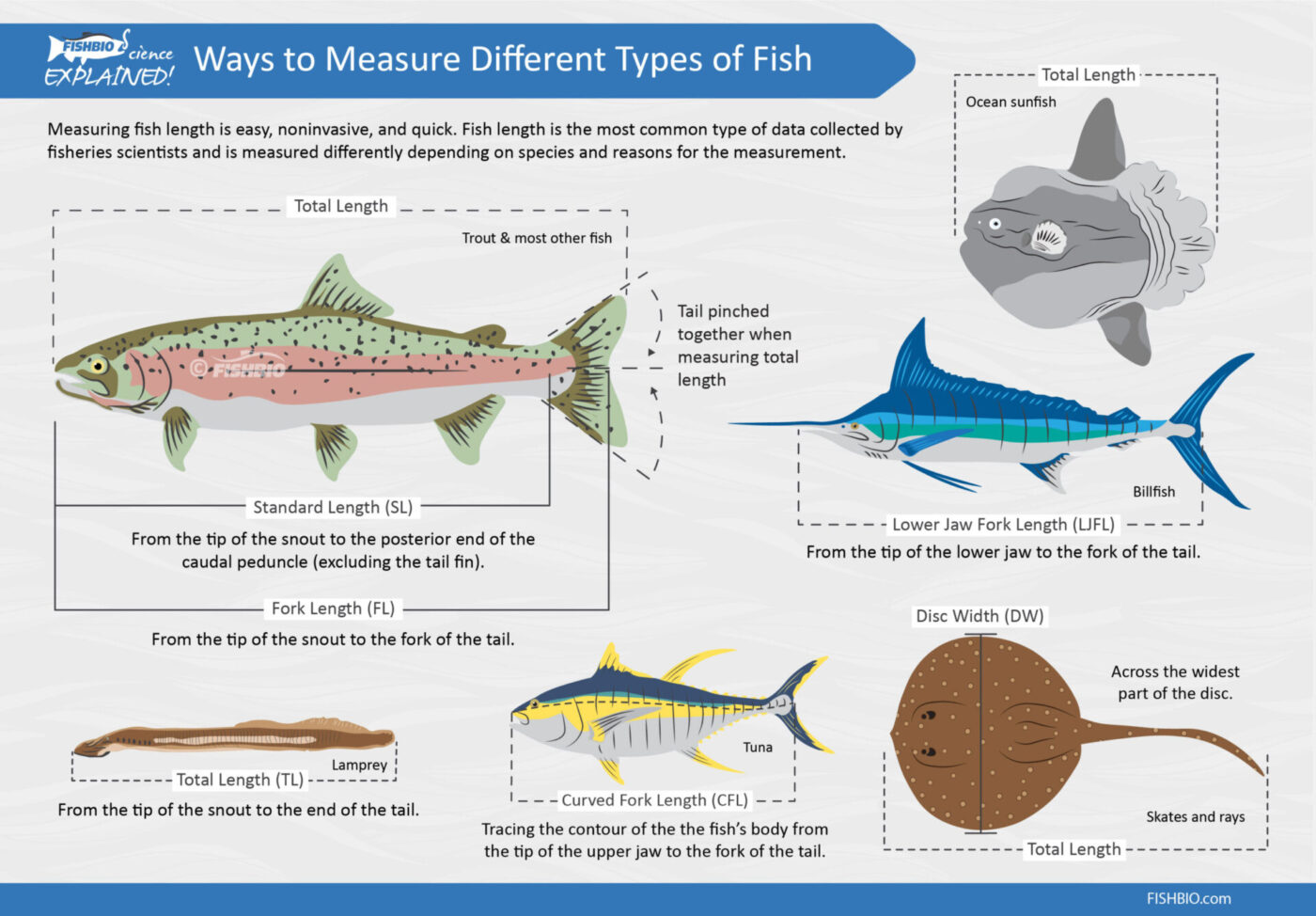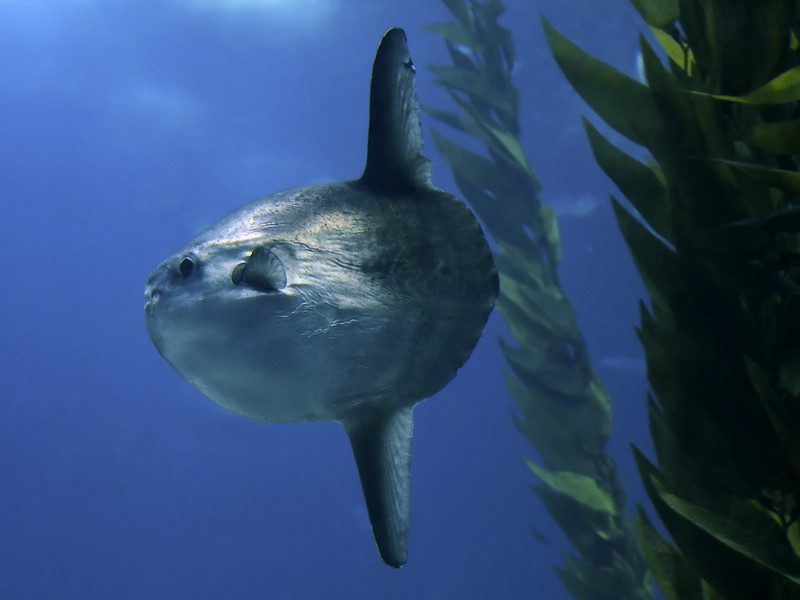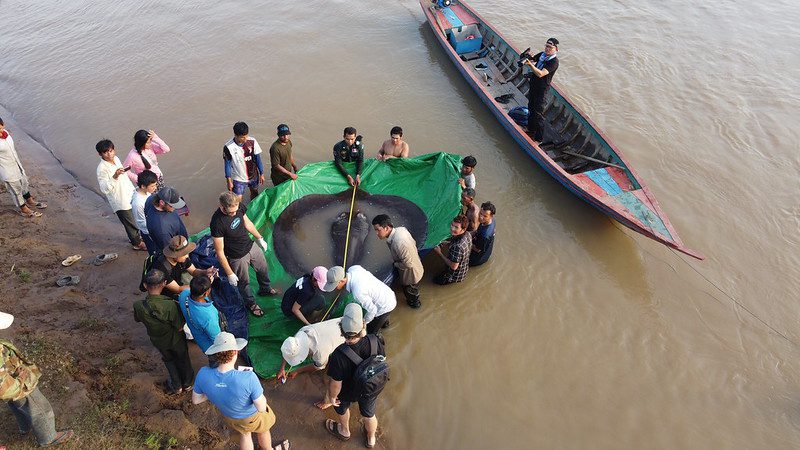Monday August 7, 2023

A common question that any fisher is all too familiar with hearing when they regale their friends with the tale of their most recent fight with a fish is, “How big was it?” Fish length is one of the most ubiquitous measurements in fisheries management and one of the most important for anglers. In fact, in any given year, FISHBIO measures thousands of fish of all different shapes and sizes. Although “length” seems a simple enough concept, the method of measuring fish length can vary depending on the species and the primary reason for taking the measurement. Typically, anglers use total length, or the distance from the fish’s snout to the end of its caudal or tail fin, which provides the longest measure of the fish. Total length is typically used to measure fish during tournaments and for harvest regulations. However, this measurement method may be affected by whether or not the recorder pinches the fish’s tail or if the caudal fin is damaged. Often, when fish length is recorded for management purposes (like monitoring rainbow trout populations), managers do not use total length, but instead use standard or fork length, depending on the species of fish measured. Fork length is the distance between the snout and the fork in the caudal fin of fishes that have forked fins, like trout and bass. Standard length is the distance between the snout and the base of the caudal fin and can be used on fish that do not have forked caudal fins like sculpin, gobies, and some catfish. These measurements are less affected by potentially damaged caudal fins and are more versatile.

However, fish come in all kinds of shapes and sizes. How does one measure oddballs like ocean sunfish (Mola species) that have a rudder-shaped clavus (tail fin) rather than a typical caudal fin; or a marlin that has a long, pointed snout; or a stingray that has wing-like pectoral fins? Fish biologists have developed a variety of measuring methods to account for the many shapes of fish in the world. Ocean sunfish are typically measured using total length from their snout to the end of their clavus. Marlin are measured by lower jaw fork length, or the distance from the tip of the lower jaw to the fork of the tail. Curved fork length, which is measured using a flexible measuring tape, measures from the tip of the upper jaw, along the curve of the fish body, to the fork in the tail. This unique measurement is used to measure football-shaped fish like tuna and some shark species. In contrast, stingrays, due to their unique morphology and tendencies for tail damage, must be measured in two ways, by length, and by disc width.

The most common questions about managed fish populations include whether they are healthy, reproducing, or growing. Getting direct answers to these questions requires extensive and often invasive sampling. Alternatively, collecting length measurements is a relatively easy, non-harmful method to obtain important fish population data. Further, length measurements are already built into most sampling procedures and monitoring protocols and can be used to inform various population models. Numerous fish experience indeterminate growth, meaning they continuously grow as they age – in contrast to humans and other animals that stop growing when they reach adulthood – which means that fish length can often be used to estimate age. Age estimates and conclusions based on length, however, are generally limited to fish within the same population, because factors like food availability and water temperature can greatly influence growth.

With those caveats in mind, managers use length-frequency distributions as a snapshot of a population’s growth and mortality trends. This information can help managers potentially anticipate fish population responses to new management actions or regulations. Another commonly used measurement is condition factor, which uses length and weight measurements to estimate the “condition” or energy reserves of a fish. In a sense, the condition factor is similar to body-mass index in humans, which is derived from measurements of height and weight. The higher the condition, the more energy reserves a fish has to grow, overwinter, reproduce, and migrate. Within a hatchery or aquaculture setting, managers may use length measurements to calculate growth rates, which in turn helps determine the growth performance of an individual or group. While direct measurements of age or energy reserves require invasive or lethal sampling of fish, length measurements are a useful, nonlethal tool that can greatly improve our understanding of fish populations. Fish length is also a great tool for anglers to have empirical data to support their bragging rights when they return from catching the beefiest rainbow on the water.
This post was featured in our weekly e-newsletter, the Fish Report. You can subscribe to the Fish Report here.
